Additive calculation flexibility supported by number relations
DOI:
https://doi.org/10.48489/quadrante.23016Keywords:
additive calculation flexibility, number relations, conceptual development, early yearsAbstract
This article aims to discuss how students in the first cycle of basic education develop the additive calculation flexibility, interconnecting it with the evolution in the construction of number concept. Two tasks are presented, one explored in a first grade and another in the second grade in the same class, with the same teacher. The data were collected through participant observation, supported by video recording and subsequent transcription of the activities developed. In the data analysis we try to understand how the students approach each of the situations in order to solve the problem and how this is intertwined with their conceptual development and the additive calculation flexibility. In both classes, the students began by exploring the tasks autonomously, followed by a moment of collective discussion. The data show an evolution in the students' flexibility of calculation interconnected with their conceptual development. Students establish numerical relationships, namely, in the first grade, the various possibilities of decomposition of 13 and the understanding of the commutative property of addition, and in the second grade, the relationships between different decompositions of the numbers that are used to deduce unknown values.
References
Baroody, A. J., & Rosu, L. (2006). Adaptive expertise with basic addition and subtraction combinations — The number sense view. In A. J. Baroody & T. Torbeyns (chairs), Developing adaptive expertise in elementary school arithmetic. Symposium conducted at: The annual meeting of the American Educational Research Association, San Francisco, California.
Brocardo, J. (2014, setembro). Exploring flexibility in mental calculation in the domain of multiplicative reasoning. Paper apresentado em ECER, Porto, Portugal.
Cobb, P., Boufi, A., McClain, K., & Whitenack, J. (1997). Reflective discourse and collective reflection. Journal for Research of Mathematics Education, 28(3), 258-277.
Erickson, F. (1986). Qualitative methods in research on teaching. In M. C. Wittrock (Ed.), Handbook of research on teaching (3ª ed.). New York: Macmillan.
Fosnot, C., & Dolk, M. (2001). Young mathematicians at work: Constructing number sense. Addition, and subtraction. Heinemann: Portsmouth.
Gravemeijer, K. (2015). Design research as a research method in education. In A. A. V. Pereira, C. Delgado, C. G. da Silva, F. Botelho, J. Pinto, J. Duarte, M. Rodrigues, & M. P. Alves (Coords.), Entre a Teoria, os Dados e o Conhecimento (III): Investigar práticas em contexto (pp. 5-19). Setúbal: Escola Superior de Educação do Instituto Politécnico de Setúbal.
Gravemeijer, K., Bruin-Muurling, G., Kraemer, J.-M., & van Stiphout, I. (2016). Shortcomings of mathematics education reform in The Netherlands: A paradigm case? Mathematical Thinking and Learning, 18(1), 25–44. http://doi.org/10.1080/10986065.2016.1107821
Gray, E., & Tall, D. (1994). Duality, ambiguity and flexibility: A proceptual view of simple arithmetic. Journal for Research in Mathematics Education, 26(2), 115-141.
Heinze, A., Marschick, F., & Lipowsky, F. (2009). Addition and subtraction of three-digit numbers: Adaptive strategy use and the influence of instruction in German third grade. ZDM Mathematics Education, 41(5), 591–604.
Heirdsfield, A., & Cooper, T. J. (2004). Factors affecting the process of proficient mental addition and subtraction: Case studies of flexible and inflexible computers. The Journal of Mathematical Behavior, 23(4), 443-463.
McIntosh, A., Reys, B., & Reys, R. (1992). A proposed framework for examining basic number sense. For the Learning of Mathematics, 12, 2-8.
Mendes, F., Brocardo, J., & Oliveira, H. (2016). Especificidades e desafios da design research: o exemplo de uma experiência de ensino no 1.º ciclo. Quadrante, 25(2), 50-75.
Morais, C., Serrazina, L., & Ponte, J. P. (2018). Números racionais no 1.º ciclo: compreensão de grandeza e densidade apoiada pelo uso de modelos. Quadrante, 27(1), 25-45.
NCTM (National Council of Teachers of Mathematics) (2000). Principles and Standards for School Mathematics. Reston, VA: NCTM.
Rathgeb-Schnierer, E., & Green, M. (2015). Cognitive flexibility and reasoning patterns in American and German elementary students when sorting addition and subtraction problems. In K. Krainer & N. Vondrová (Eds.), Proceedings of the Ninth Congress of the European Society for Research in Mathematics Education (pp. 339-345). Prague: Charles University in Prague, Faculty of Education and ERME.
Serrazina, L., & Rodrigues, M. (2017). ‘Day number’: A promoter routine of flexibility and conceptual understanding. Journal of Mathematics Education, 10(2), 67-82. doi.org/10.26711/007577152790013.
Serrazina, L., & Rodrigues, M. (2014). A tarefa como instrumento de desenvolvimento da flexibilidade de cálculo. In J. Brocardo, A. Boavida, C. Delgado, E. Santos, F. Mendes, J. Duarte, M. Baía & M. Figueiredo (Eds.), Livro de Atas do Encontro de Investigação em Educação Matemática (EIEM 2014) (pp. 109–120). Setúbal: Escola Superior de Educação do Instituto Politécnico de Setúbal.
Sfard, A. (1991). On the dual nature of mathematical conceptions: Reflections on processes and objects as different sides of the same coin. Educational Studies in Mathematics Education, 22, 1-36.
Star, J. R., & Newton, K. J. (2009). The nature and development of experts’ strategy flexibility for solving equations. ZDM Mathematics Education, 41, 557-567.
Tall, D. (2013). How humans learn to think mathematically: Exploring the three worlds of mathematics (Learning in doing: social, cognitive and computational perspectives). Cambridge: Cambridge University Press.
Threlfall, J. (2009). Strategies and flexibility in mental calculation. ZDM Mathematics Education, 41, 541-555.
Verschaffel, L., Luwel, K., Torbeyns, J., & Dooren, W. V. (2009). Conceptualizing, investigating, and enhancing adaptive expertise in elementary mathematics education. European Journal of Psychology of Education, 24(3), 335-259.










